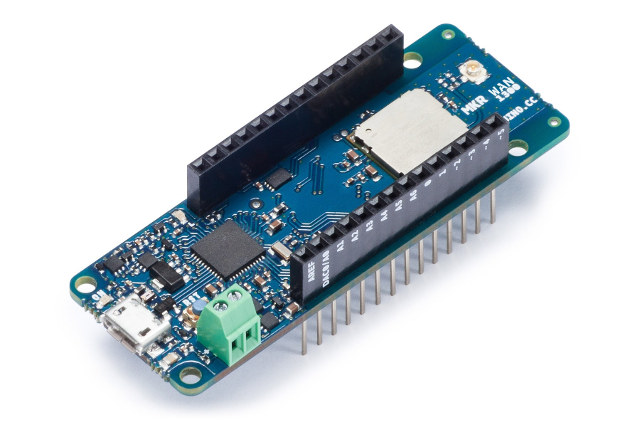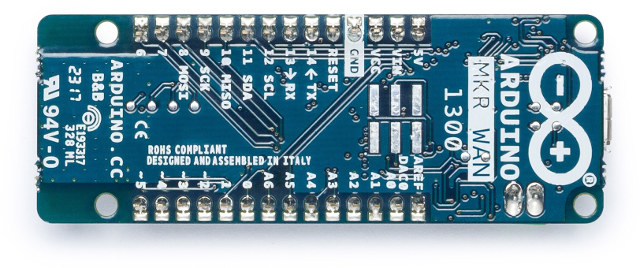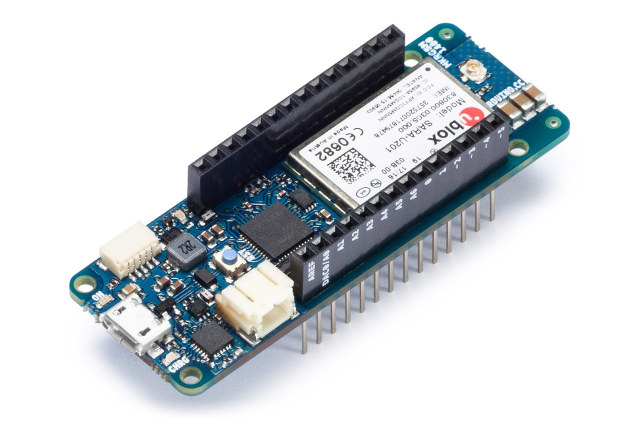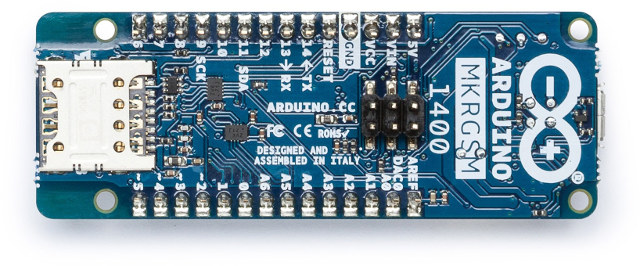Arduino has introduced two new boards right in time for Maker Faire New York: MKR WAN 1300 with a LoRa radio, and MKR GSM 1400 with a “3.75G” cellular module, both software compatible with Arduino Zero, and in Arduino MKRZero board form factor.
MKR WAN 1300 Board

Arduino MKR WAN 1300 specifications:
- MCU – Microchip Atmel SAMD21 32-bit ARM Cortex M0+ MCU @ 48 MHz with 32 KB SRAM, 256 KB flash (8KB for bootloader)
- Digital I/O Pins – 8x digital I/Os, 12x PWM, UART, SPI, and I2C, 8x external interrupts
- Analog Pins – 7x analog inputs (8/10/12-bit ADC), and 1x analog output (10-bit DAC)
- DC Current per I/O Pin – 7 mA
- LPWAN connectivity
- Murata CMWZ1ZZABZ LoRa module based on Semtech SX1276 and STMicro STM32L
- Antenna power – 2dB
- Carrier frequency – 433/868/915 MHz
- Working regions – EU/US
- USB – 1x micro USB port for power and programming
- Misc – Reset button, 6x LEDs, 32.768 kHz RTC
- Power
- 5V via micro USB port or Vin pin
- 2x AA or AAA batteries support
- I/O Operating Voltage – 3.3V
- Dimensions – 67.64 x 25 mm
- Weight – 32 grams
 It’s interesting to note that the Murata module includes an STM32L MCU, and exposes ADC/DAC, GPIOs, SPI, I2C.. pins, so in theory it would be possible to create a similar board without the Microchip/Atmel chip, but Arduino IDE compatibility may have suffered despite work on Arduino STM32, and the exposed I/Os could not be the same (e.g. only 4x ADC).
It’s interesting to note that the Murata module includes an STM32L MCU, and exposes ADC/DAC, GPIOs, SPI, I2C.. pins, so in theory it would be possible to create a similar board without the Microchip/Atmel chip, but Arduino IDE compatibility may have suffered despite work on Arduino STM32, and the exposed I/Os could not be the same (e.g. only 4x ADC).
MKR GSM 1400

Arduino MKR GSM 1400 board has very similar specifications, except it replaces the LoRa radio with a u-blox cellular module, and supports LiPo batteries:
- MCU – Microchip Atmel SAMD21 32-bit ARM Cortex M0+ MCU @ 48 MHz with 32 KB SRAM, 256 KB flash (8KB for bootloader)
- Digital I/O Pins – 8x digital I/Os, 12x PWM, UART, SPI, and I2C, 8x external interrupts
- Analog Pins – 7x analog inputs (8/10/12-bit ADC), and 1x analog output (10-bit DAC)
- DC Current per I/O Pin – 7 mA
- Cellular Connectivity
- u-blox SARAU201 cellular module supporting 3.75G UMTS/HSPA with 2G GSM/(E)GPRS fallback
- NanoSIM card slot
- u.FL connector for external antenna
- Working regions – Global
- USB – 1x micro USB port for power and programming
- Misc – Reset button, 6x LEDs, 32.768 kHz RTC
- Power
- 5V via micro USB port
- 5V to 12V Vin pin
- 3.7V LiPo battery support
- I/O Operating Voltage – 3.3V
- Dimensions – 67.64 x 25 mm
- Weight – 32 grams
 Both boards are up for pre-order with shipping expected for November 15th with MKR WAN 1300 going for $39 / 35 Euros excluding VAT, and MKR GSM 1400 selling for $69.00 / 59.90 Euros excluding VAT. Further documentation is accessible through the store links.
Both boards are up for pre-order with shipping expected for November 15th with MKR WAN 1300 going for $39 / 35 Euros excluding VAT, and MKR GSM 1400 selling for $69.00 / 59.90 Euros excluding VAT. Further documentation is accessible through the store links.

Jean-Luc started CNX Software in 2010 as a part-time endeavor, before quitting his job as a software engineering manager, and starting to write daily news, and reviews full time later in 2011.
Support CNX Software! Donate via cryptocurrencies, become a Patron on Patreon, or purchase goods on Amazon or Aliexpress





7ma per io max…not enought to drive a led or an optocoupler lol
12ma for esp8266
25ma for PIC16F
The LoRa MKR 1300 specs seem a bit limited. Why a Tx power of only +2dBm or is it a typo ? I read LoRa Tx power is normally at least +14dBm, ranging upto +20dBm. Is there a Link budget ?
@Paul
That’s what Arduino wrote on their product page, but it must be an error.
Should it be possible to derive the link budget from the Murata datasheet?
The Murata datasheet is just 15 pages versus 129 pages for the Semtech LoRa module SX1272. Semtech’s datasheet on page 1 under ‘KEY PRODUCT FEATURES’ give a clear unambiguous 157 dB Max Link Budget – derived I assume from the +20dBm max Tx power & ‘High Sensitivity down to -137dBm’
Murata have no key feature list, but delving into the spec detail, on page6 one can see a not disimilar +14dBm to 18.5dBm Tx power, and on page 7 a big range of Rx sensitivity from -117.5dBm to -133.0dBm depending on bandwidth & SF. So it would appear the Murata will have less range than the Semtech. However, I think it can be dangerous to rely on chipmaker specs when boardmakers too lazy or refuse to properly specify their products. For example, I have searched for some time without success for the typical max real-world WiFi data transfer rate of SBCs using ESP 8266 & ESP32 modules; hardly any boardmakers state anything beyond WiFiAlliance theoretical figures for b,g,n,ac. Measuring their product seems just too much effort, requiring customers to find out the hard way. (although not in their prelim spec, at least the Khadas VIM2 rep kind of answered the question on your site last July but didnt specify which model he tested) Reason I am reluctant to use chip specs as board specs, is for the ESP32 based ‘LoPi’ the unusually well-specd board states WiFi limited to 16Mbps, whereas from the ESP32 datasheet one might reasonably expect 65Mbps in MCS7 single antenna. Why such a drastic reduction from ESP32 datasheet figure to Pycom’s own board spec ? Although disappointing (as 65Mbps met my use-case) I am pleased Pycom are open enough to let potential buyers beware.
At first glance the Murata appears to consume more power than the Semtech.